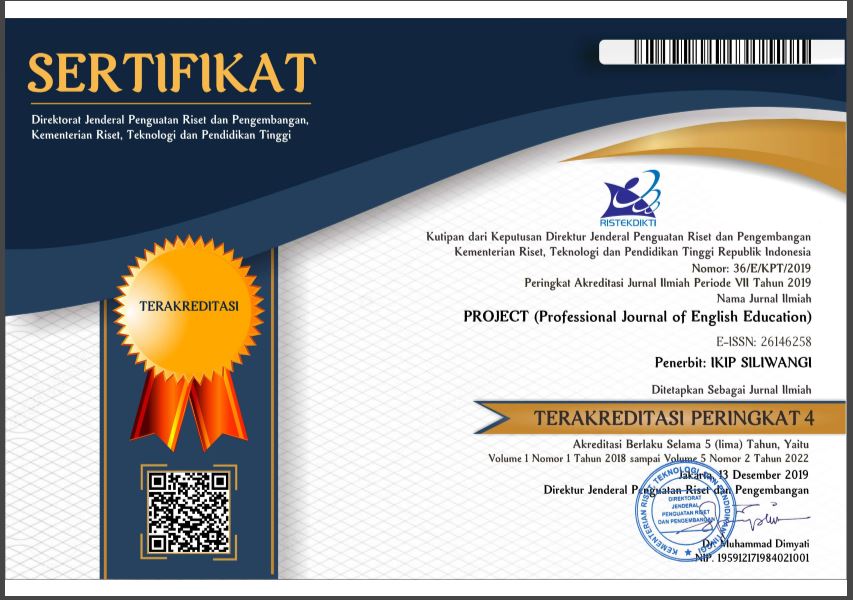More Than Just Words: Media Literacy and The Development of EFL Writing Class
Abstract
The study concentrated on the opinions and experiences of second-year students enrolled in a writing course that emphasizes media literacy. A case study design is appropriate for this research as it allows for an in-depth exploration of the effects of media literacy-based activities on EFL writing skills within a specific context. Questionnaires on media attitudes and how it affects their writing skills were used to collect data. According to the findings, most students thought that the media literacy exercises improved their ability to think critically, comprehend media messages, and communicate effectively in English. The present study thus underscores the need to embed media literacy into the EFL curriculum to enhance critical thinking among learners and to improve their writing competence. Further research is welcome to help refine these pedagogical strategies and resolve contextual challenges for the best learning outcomes.
References
Aiju, L., & Abdullah, A. (2024). Using E-modules to Support EFL/ESLLearning in Asian Contexts: A Systematic Literature Review. The English Teacher, 57-72.
Asadzandi, S., Shahbodaghi, A., Sajjadi, S., Kamkarhaghighi, M., & Hemmat, M. (2013). A scientometric study of media literacy literature based on Scopus record through 2011. Journal of Paramedical Sciences (JPS) , 49-55.
Bacha, N. N. (2019). Writing the Argumentative Literary Review in EFL/ESLContexts: A Critical Analysis Perpective. International Journal for InnovationEducation and Research, 229-240.
Balle, S. H., & Olsen, M. (2023). From Words to Text - Academic Writing in EFL Classrooms. Nordic Journal of Language Teaching and Learning, 16-27.
Dore, R., Logan, J., Lin, T., Purtell, K., & Justice, L. (2020). Characteristics of children’s media use and gains in language and literacy skills. Frontiers in Psychology, 11. https://doi.org/10.3389/fpsyg.2020.02224
Falk-Ross, F., & Linder, R. (2009). Reading and Writing Connections using Media: Addressing th eLiteracy Needs of Students in Intermediate and Middle Level Classrooms. The Language and Literacy Spectrum, 29-38.
Hadiapurwa, A. (2023). Social media usage for language literacy development in indonesia. Jurnal Kajian Informasi & Perpustakaan, 11(1), 109. https://doi.org/10.24198/jkip.v11i1.40208
Hafizha, R. (2023). Exploring parental language ideology and language enrichment in indonesian children’s translingual practices. Joall (Journal of Applied Linguistics and Literature), 8(2), 227-244. https://doi.org/10.33369/joall.v8i2.24934
Jalilifar, A., Alipour, M., & Rabiee, M. (2017). A Comparative Study of Thematicity in the Argumentative WRiting of University EFL Students and the Introduction Section of Research Articles. Journal of Teaching Language Skills (JTLS), 85-110.
Klimova, B., & Pikhart, M. (2019). Cognitive and Applied Linguistics Aspects of Using Social Media: The Impact of the Use of FAcebook on DEveloping Writing Skills in Learning English as a Foreign Language. European Journal of Investigation in Health, Psychology and Education, 110-118.
Lazarenko, I. S., Rybak, T. M., Konovalova, V. A., & Moroz, M. V. (2022). Development of Media Literacy of Applicants for Agronomic Specialities by the Means of Journalistic Webquests. Zhytomyr Ivan Franko State University Journal. Pedagogical Sciences, 209-218.
Nguyen, T. (2022). Promoting Students' Reviewing Skills in Foreign Language Writing through Genre-bsed Activities in Linguistics Classes. Journal of Foreign Language Teaching and LEarning, 300-327.
Olasina, G. (2017). An Evaluation of Educational Values of YouTube Videos for Academic Writing. The African Journal of Information Systems, 232-261.
Poncelet, E. M. (2015). Is that Your Final Answer: Testing Perceptual Asymmetry Biases on Responses to Likert-Scales. University of Saskatchewan Undergraduate Research Journal, 107-114.
Pozzar, R. A., Berry, D. L., & Hong, F. (2019). Item response theory analysis and properties conflict scales: findings from two multi-site trials of men with localized prostate cancer. BMC Medical Informatics and Decision Making, 1-9.
Ramadhanti, R., Oktaviana, F., Tarohoran, N., & Fitriani, D. (2023). Challenges, Strategies, and Digital Media Use in Writing Research Articles: A Study of EFL Postgraduate Students . SCOPE: Journal of English Language Teaching, 167-175.
Salem, A. A. (2022). Multimedia Presentations through Digital Storytelling for Sustainable DEvelopment of EFL Learners' Argumentative Writing Skills, Self-Directed LEarning Skills and LEarner Autonomy. Frontiers in Education, 1-14.
Sastre, M. S., & Morancho, L. L. (2016). Scientific Studies on Literacy and Digital Literacy Indexed in Scopus: A Literature Review (2000-2013). Actualidades Pedagogicas, 197-215.
Sikstrom, S., Hook, A. P., & Kjell, O. (2023). Precise language responses versus easy rating scales-COmparing respondents' views with clinicians' belief of the respondent's views. PLOS ONE, 1-14.
Sulistiyani, D., Mujiyanto, J., & Suwandi. (2022). An Analysis of Rhetorical Structures of Introduction Sections in International Conference Papers. English Education Journal, 234-251.
Wulan, D. R., Drajati, N. A., & Supriyadi, S. (2022). Exploring EFL Students' Digital Multimodal Composing (DMC) Affordance: Stories from a Vocational School. I-Ishlah: Jurnal Pendidikan, 2007-2018.
Downloads
Published
Issue
Section
License

This work is licensed under a Creative Commons Attribution-ShareAlike 4.0 International License.




